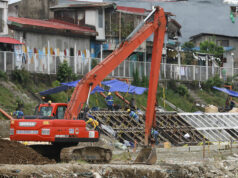Angat expected to breach all-time low by Saturday, water regulator says
WITHOUT significant rainfall flowing to its watershed, Angat Dam is expected to breach the lowest recorded level of 157.57 meters by Saturday according to the National Water Resources Board (NWRB).
NWRB Executive Director Sevillo D. David, Jr. said at a briefing: “If the situation continues we are expecting the level of the Angat Dam to breach the lowest recorded level of 157.57 (meters) by end of this week,” Mr. David said.
At 6 a.m. on Wednesday, Angat Dam was at 158.4 meters, 21.6 meters below its rated minimum operating level of 180 meters. The latest level is 0.8 meters away from the lowest recorded level of 157.57 meters on July 13, 2010.
The NWRB also decided to maintain the current allocation of 36 cubic meters per second to concessionaires for the rest of June up to the first week of July.
Mr. David, Jr. said holding the current water allocation to concessionaires is due to the projected monsoon rains around Angat watershed, but any divergence from the weather forecast could still push the agency to adjust the allocations.
Chief of Climate Monitoring and Prediction Annaliza Solis from the government weather service, known as PAGASA, said the weather service is expecting monsoon rains in the coming days.
“Inaasahan po natin (We are expecting) starting this week up to at least week one po ng (of) July, inaasahan natin may mga tinatawag na mga (we are expecting what we call) monsoon rains na dahil papalabas po ’yung bagyo ngayon, hahatak po ’yan ng Habagat. (because the tropical depression is going out, it will pull in the monsoon). We hope may mga ulan po na makaka-contribute sa pagdagdag ng tubig ulan sa Angat Dam. (there will be rains that can contribute to the rainfall in Angat Dam)” she added.
Ms. Solis said that the weather service is expecting rainfall in Angat Dam in July and August to be near normal. The El Niño phenomenon is also expected to end by August, although there is a possibility for it to continue until first quarter of 2020.
According to Ms. Solis, Angat Dam only received 118 mm of rain from June 1 to 25, or 36% of the normal amount of rain it should get during the period. The dam typically gets 332.4 mm of rain for the month.
Maynilad Water Services, Inc. spokesperson Jennifer C. Rufo said in a text message, “As long as the raw water allocation for Metro Manila remains at the reduced level of 36 CMS, we are constrained to continue implementation of the current rotational service interruption scheme.”
“As distributors of water supply, we can only distribute what is given to us, and just maximize that limited supply so that all affected customers will have some water supply daily,” she added.
Meanwhile, Manila Water Co., Inc., group head for corporate strategic affairs Nestor Jeric T. Sevilla, Jr. said, “We will continue to implement our rotational service interruptions until the NWRB decides on a new water allocation.”
Currently, rotational water interruptions for areas covered by the Manila Water range from 12-17 hours while areas served by Maynilad are experiencing 14 hours of interruption on average.
The current water allocation of 36 cubic meters per second amounts to 3.1 billion liters per day, 10 cubic meters short of the normal 46 cubic meters per second, which is equivalent to 4 billion liters per day, Mr. David said. — Katrina T. Mina



